Free Dumps, Free Microsoft Dump
Free AZ-900 Dump
Question #81Topic 1
HOTSPOT –
Select the answer that correctly completes the sentence.
Hot Area:
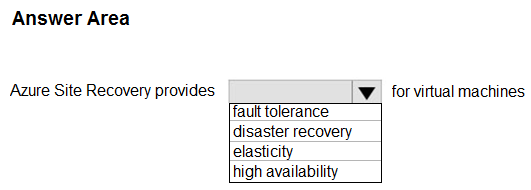
Correct Answer: 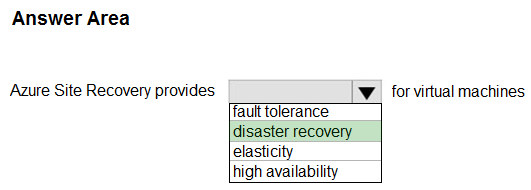
You set up disaster recovery for Azure VMs using Azure Site Recovery.
Reference:
https://docs.microsoft.com/en-us/azure/site-recovery/azure-to-azure-tutorial-enable-replication
Question #82Topic 1
HOTSPOT –
You plan to use Azure to host two apps named App1 and App2. The apps must meet the following requirements:
✑ You must be able to modify the code of App1.
✑ Administrative effort to manage the operating system of App1 must be minimized.
✑ App2 must run interactively with the operating system of the server.
Which type of cloud service should you use for each app? To answer, select the appropriate options in the answer area.
NOTE: Each correct selection is worth one point.
Hot Area:
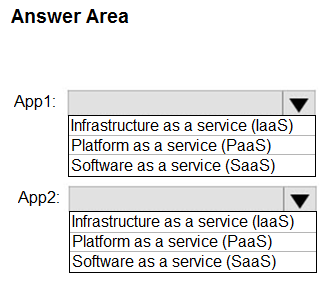
Correct Answer: 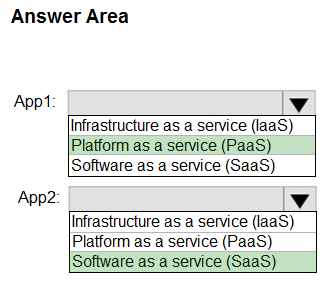
Box 1: Azure Platform as a service (PaaS)
Organizations typically use PaaS for these scenarios:
Development framework. PaaS provides a framework that developers can build upon to develop or customize cloud-based applications. Similar to the way you create an Excel macro, PaaS lets developers create applications using built-in software components. Cloud features such as scalability, high-availability, and multi-tenant capability are included, reducing the amount of coding that developers must do.
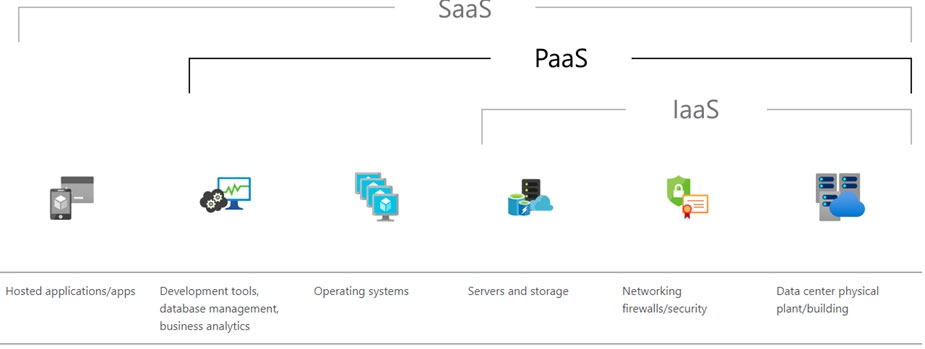
Box 2:
Software as a service (SaaS) allows users to connect to and use cloud-based apps over the Internet. Common examples are email, calendaring, and office tools
(such as Microsoft Office 365).
SaaS provides a complete software solution that you purchase on a pay-as-you-go basis from a cloud service provider. You rent the use of an app for your organization, and your users connect to it over the Internet, usually with a web browser. All of the underlying infrastructure, middleware, app software, and app data are located in the service provider’s data center. The service provider manages the hardware and software, and with the appropriate service agreement, will ensure the availability and the security of the app and your data as well. SaaS allows your organization to get quickly up and running with an app at minimal upfront cost.
Reference:
https://azure.microsoft.com/en-us/overview/what-is-paas/
Question #83Topic 1
You have an accounting application named App1 that uses a legacy database.
You plan to move App1 to the cloud.
Which service model should you use?
- A. platform as a service (PaaS)
- B. infrastructure as a service (IaaS)
- C. software as a service (SaaS)
Correct Answer: B
Cloud Infrastructure-based Applications ” It moves your existing on-premises apps to the Infrastructure as a Service (IaaS) platform or re-hosts them. Lift & Shift is a common term for this type of relocation. The programs will be nearly identical to what they were before, but they will now be able to run on cloud VMs.
Reference:
https://techtaalk.com/microsoft-azure-for-legacy-application-modernization/
Community vote distribution
B (94%)
6%
Question #84Topic 1
HOTSPOT –
Select the answer that correctly completes the sentence.
Hot Area:

Correct Answer: 
Box: configuring the Saas Solution
Software as a service (or SaaS) is a way of delivering applications over the Internet”as a service. Instead of installing and maintaining software, you simply access it via the Internet, freeing yourself from complex software and hardware management.
SaaS applications are sometimes called Web-based software, on-demand software, or hosted software. Whatever the name, SaaS applications run on a SaaS provider’s servers. The provider manages access to the application, including security, availability, and performance.
Reference:
https://www.salesforce.com/in/saas/
Question #85Topic 1
HOTSPOT –
Select the answer that correctly completes the sentence.
Hot Area:

Correct Answer: 
Box: hybrid –
You can deploy hybrid app with on-premises data that scales cross-cloud.
Reference:
https://docs.microsoft.com/en-us/azure/architecture/hybrid/deployments/solution-deployment-guide-cross-cloud-scaling-onprem-data
Question #86Topic 1
HOTSPOT –
Select the answer that correctly completes the sentence.
Hot Area:

Correct Answer: 
Box: Platform as a service (PaaS)
Platform as a service (PaaS) is a complete development and deployment environment in the cloud, with resources that enable you to deliver everything from simple cloud-based apps to sophisticated, cloud-enabled enterprise applications. You purchase the resources you need from a cloud service provider on a pay- as-you-go basis and access them over a secure Internet connection.
Like IaaS, PaaS includes infrastructure”servers, storage, and networking”but also middleware, development tools, business intelligence (BI) services, database management systems, and more.
Reference:
https://azure.microsoft.com/en-us/overview/what-is-paas/
Question #87Topic 1
Which cloud computing model includes on-premises and cloud-based resources?
- A. hybrid
- B. public
- C. private
Correct Answer: A
A hybrid cloud ” sometimes called a cloud hybrid ” is a computing environment that combines an on-premises datacenter (also called a private cloud) with a public cloud, allowing data and applications to be shared between them. Some people define hybrid cloud to include multicloud configurations where an organization uses more than one public cloud in addition to their on-premises datacenter.
Reference:
https://azure.microsoft.com/en-us/overview/what-is-hybrid-cloud-computing/
Community vote distribution
A (100%)
Question #88Topic 1
HOTSPOT –
Select the answer that correctly completes the sentence.
Hot Area:

Correct Answer: 
An Azure virtual machine scale set can automatically increase or decrease the number of VM instances that run your application. This automated and elastic behavior reduces the management overhead to monitor and optimize the performance of your application.
Also: Azure elasticity as a service is referred to a cloud service that enables in automatically scaling Azure hosted resources in par with the demand and configured parameters. It provides Azure Administrators with the ability to auto scale Azure infrastructure and resources as and when needed.
Reference:
https://docs.microsoft.com/en-us/azure/virtual-machine-scale-sets/virtual-machine-scale-sets-autoscale-overview https://www.netreo.com/cloud-automation/what-is-azure-elasticity-as-a-service/
Question #89Topic 1
HOTSPOT –
Select the answer that correctly completes the sentence.

Correct Answer: 
Question #90Topic 1
Which term represents the ability to increase the computing capacity of a virtual machine by adding memory or CPUs?
- A. agility
- B. vertical scaling
- C. horizontal scaling
- D. elasticity
Correct Answer: B
Vertical scaling, also known as scale up and scale down, means increasing or decreasing virtual machine (VM) sizes in response to a workload. Compare this behavior with horizontal scaling, also referred to as scale out and scale in, where the number of VMs is altered depending on the workload.
Reference:
https://docs.microsoft.com/en-us/azure/virtual-machine-scale-sets/virtual-machine-scale-sets-vertical-scale-reprovision
Community vote distribution
B (100%)
Question #91Topic 1
What are two benefits of cloud computing? Each correct answer presents a complete solution.
NOTE: Each correct selection is worth one point.
- A. enables the rapid provisioning of resources
- B. has increased administrative complexity
- C. has the same configuration options as on-premises
- D. shifts capital expenditures (CAPEX) to operating expenditures (OPEX)
Correct Answer: AD
Azure allows you to build, deploy, and manage apps more quickly and easily without having to buy and/or maintain the underlying infrastructure.
Azure provides flexibility between CapEx and OpEx
Capital expenditures generate benefits over a long period. These expenditures are generally nonrecurring and result in the acquisition of permanent assets.
Building an application could qualify as a capital expenditure. Example, Azure Reserved Instances (Azure RI) help Azure’s most active customers save on long- term VM usage reserving VMs in advance at a discounted price by committing to a one or three-year benefits.
Operating expenditures are ongoing costs of doing business. Consuming cloud services in a pay-as-you-go model could qualify as an operating expenditure.
Example, you pay for a service or product as you use it i.e. pay-as-you-go pricing.
Reference:
https://www.protechtraining.com/blog/post/top-5-benefits-of-microsoft-azure-for-business-934 https://www.azureguru.org/capex-vs-opex/#
Community vote distribution
AD (100%)
Question #92Topic 1
What is a feature of an Azure virtual network?
- A. resource cost analysis
- B. packet inspection
- C. geo-redundancy
- D. isolation and segmentation
Correct Answer: D
Implement network segmentation patterns on Azure.
A unified enterprise segmentation strategy guides technical teams to consistently segment access using networking, applications, identity, and any other access controls. Create segmentation in your network footprint by defining perimeters.
The main reasons for segmentation are:
The ability to group related assets that are a part of (or support) workload operations.
Isolation of resources.
Governance policies set by the organization.
Reference:
https://docs.microsoft.com/en-us/azure/architecture/framework/security/design-network-segmentation
Community vote distribution
D (100%)
Question #93Topic 1
HOTSPOT –
Select the answer that correctly completes the sentence.
Hot Area:

Correct Answer: 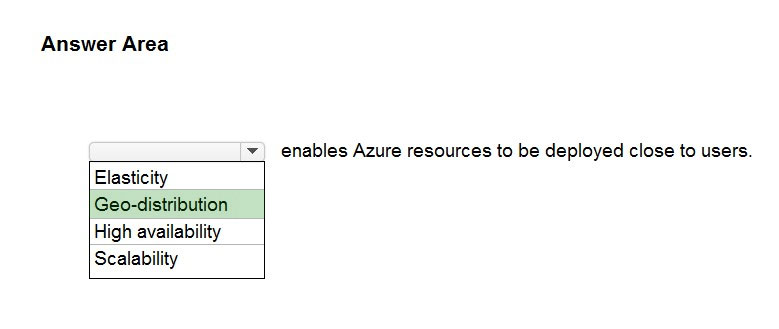
Because of geo-distribution you can deploy apps and data to regional datacenters around the globe, thereby ensuring that your customers always have the best performance in their region.
Reference:
https://docs.microsoft.com/learn/modules/fundamental-azure-concepts/benefits-of-cloud-computing
Question #94Topic 1
DRAG DROP –
Match the cloud computing benefits to the appropriate descriptions.
To answer, drag the appropriate benefit from the column on the left to its description on the right. Each benefit may be used once, more than once, or not at all.
NOTE: Each correct match is worth one point.
Select and Place:
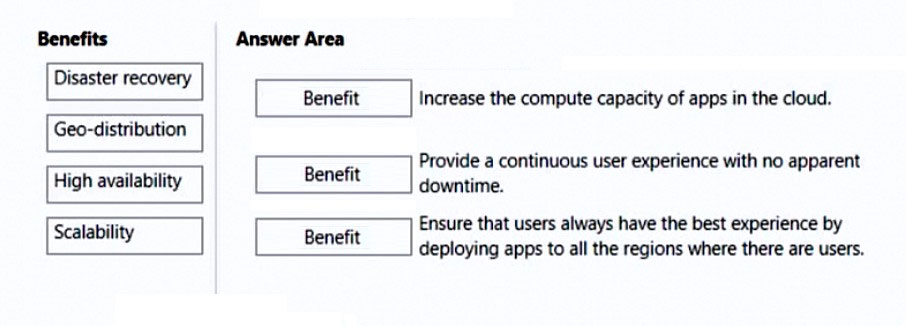
Correct Answer: 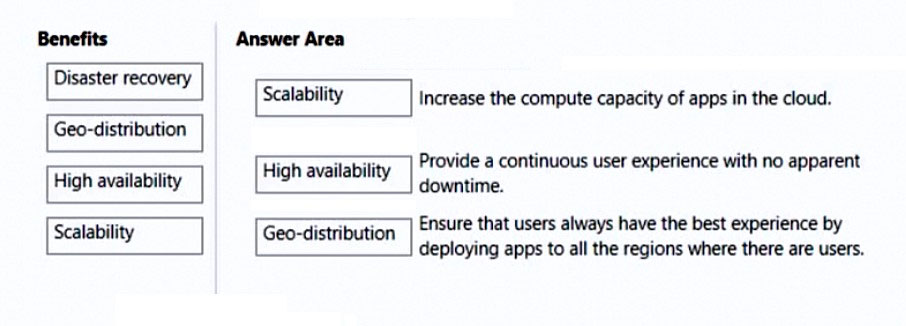
Reference:
https://docs.microsoft.com/learn/modules/fundamental-azure-concepts/benefits-of-cloud-computing
Question #95Topic 1
Which cloud computing benefit provides continuous user access to a cloud-based application with minimal downtime?
- A. agility
- B. scalability
- C. elasticity
- D. high availability
Correct Answer: D
Community vote distribution
D (100%)
Question #96Topic 1
You need to identify the type of failure for which an Azure Availability Zone can be used to protect access to Azure services.
What should you identify?
- A. a physical server failure
- B. an Azure region failure
- C. a storage failure
- D. an Azure data center failure
Correct Answer: D
Availability zones expand the level of control you have to maintain the availability of the applications and data on your VMs. An Availability Zone is a physically separate zone, within an Azure region. There are three Availability Zones per supported Azure region.
Each Availability Zone has a distinct power source, network, and cooling. By architecting your solutions to use replicated VMs in zones, you can protect your apps and data from the loss of a datacenter. If one zone is compromised, then replicated apps and data are instantly available in another zone.
Reference:
https://docs.microsoft.com/en-us/azure/virtual-machines/availability
Community vote distribution
D (100%)
Question #97Topic 1
HOTSPOT –
You plan to extend your company’s network to Azure.
The network contains a VPN appliance that uses an IP address of 131.107.200.1.
You need to create an Azure resource that defines the VPN appliance in Azure.
Which Azure resource should you create? To answer, select the appropriate resource in the answer area.
Hot Area:
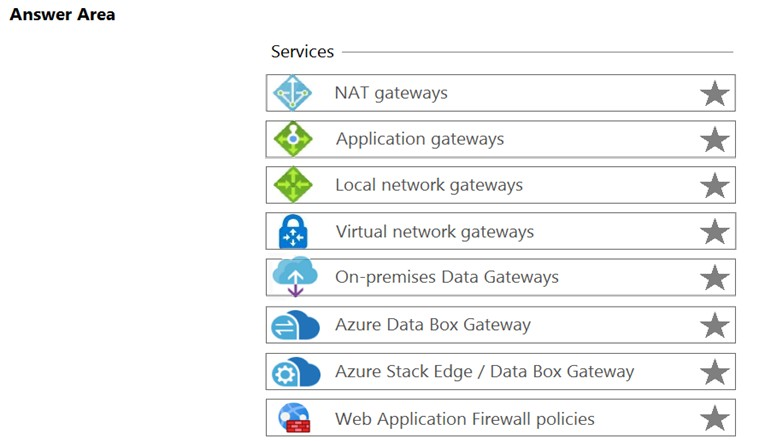
Correct Answer: 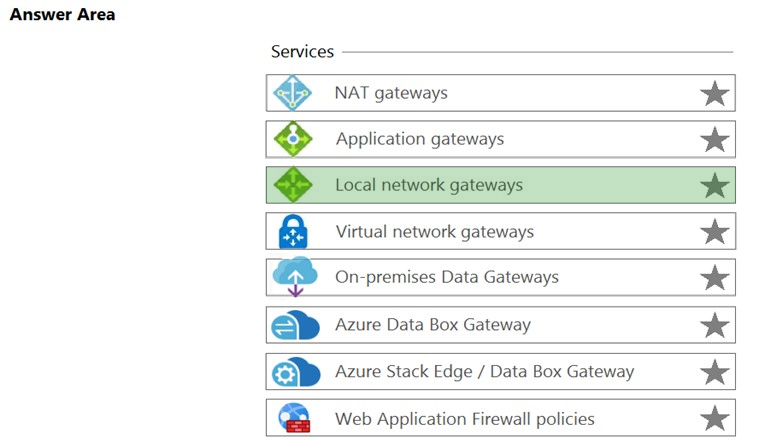
A Local Network Gateway is an object in Azure that represents your on-premise VPN device. A Virtual Network Gateway is the VPN object at the Azure end of the
VPN. A ‘connection’ is what connects the Local Network Gateway and the Virtual Network Gateway to bring up the VPN.
The local network gateway typically refers to your on-premises location. You give the site a name by which Azure can refer to it, then specify the IP address of the on-premises VPN device to which you will create a connection. You also specify the IP address prefixes that will be routed through the VPN gateway to the VPN device. The address prefixes you specify are the prefixes located on your on-premises network. If your on-premises network changes or you need to change the public IP address for the VPN device, you can easily update the values later.
Reference:
https://docs.microsoft.com/en-us/azure/vpn-gateway/vpn-gateway-howto-site-to-site-resource-manager-portal
Question #98Topic 1
Note: This question is part of a series of questions that present the same scenario. Each question in the series contains a unique solution that might meet the stated goals. Some question sets might have more than one correct solution, while others might not have a correct solution.
After you answer a question in this section, you will NOT be able to return to it. As a result, these questions will not appear in the review screen.
You plan to deploy several Azure virtual machines.
You need to ensure that the services running on the virtual machines are available if a single data center fails.
Solution: You deploy the virtual machines to two or more resource groups.
Does this meet the goal?
- A. Yes
- B. No
Correct Answer: B
A resource group is a logical container for Azure resources. When you create a resource group, you specify which location to create the resource group in.
However, when you create a virtual machine and place it in the resource group, the virtual machine can still be in a different location (different datacenter).
Therefore, creating multiple resource groups, even if they are in separate datacenters does not ensure that the services running on the virtual machines are available if a single data center fails.
References:
https://docs.microsoft.com/en-us/azure/azure-resource-manager/management/overview#resource-groups
Community vote distribution
B (100%)
Question #99Topic 1
Note: This question is part of a series of questions that present the same scenario. Each question in the series contains a unique solution that might meet the stated goals. Some question sets might have more than one correct solution, while others might not have a correct solution.
After you answer a question in this section, you will NOT be able to return to it. As a result, these questions will not appear in the review screen.
You plan to deploy several Azure virtual machines.
You need to ensure that the services running on the virtual machines are available if a single data center fails.
Solution: You deploy the virtual machines to a scale set.
Does this meet the goal?
- A. Yes
- B. No
Correct Answer: B
This answer does not specify that the scale set will be configured across multiple data centers so this solution does not meet the goal.
Azure virtual machine scale sets let you create and manage a group of load balanced VMs. The number of VM instances can automatically increase or decrease in response to demand or a defined schedule. Scale sets provide high availability to your applications, and allow you to centrally manage, configure, and update many VMs.
Virtual machines in a scale set can be deployed across multiple update domains and fault domains to maximize availability and resilience to outages due to data center outages, and planned or unplanned maintenance events.
Reference:
https://docs.microsoft.com/en-us/azure/virtual-machine-scale-sets/availability
Community vote distribution
B (100%)
Question #100Topic 1
HOTSPOT –
For each of the following statements, select Yes if the statement is true. Otherwise, select No.
NOTE: Each correct selection is worth one point.
Hot Area:

Correct Answer: 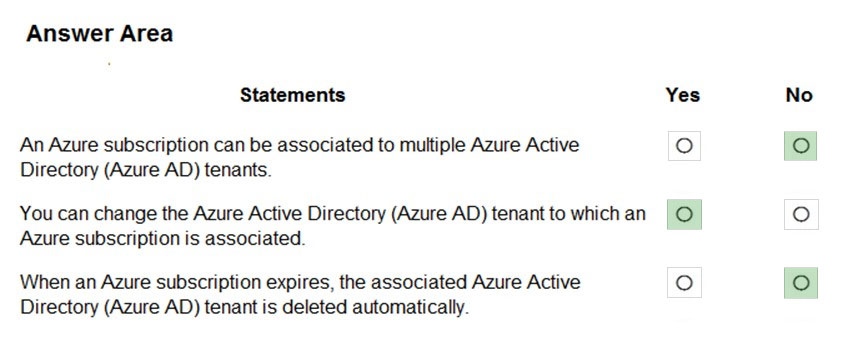
Box 1: No –
An Azure AD tenant can have multiple subscriptions but an Azure subscription can only be associated with one Azure AD tenant.
Box 2: Yes –
Box 3: No –
If your subscription expires, you lose access to all the other resources associated with the subscription. However, the Azure AD directory remains in Azure. You can associate and manage the directory using a different Azure subscription.
References:
https://docs.microsoft.com/en-us/azure/active-directory/fundamentals/active-directory-how-subscriptions-associated-directory

